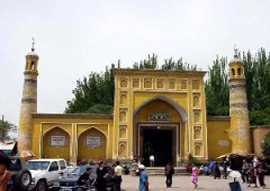Kashgar's majestic yellow-tiled Id Kah Mosque (Aitigaer Qingzhensi) has been the heart of the region's traditional Muslim culture since its completion in 1442. Today, it remains one of China's largest  mosques, frequently hosting ten to twenty thousand worshippers on holy days. mosques, frequently hosting ten to twenty thousand worshippers on holy days.
Visitors are tolerated but only to the extent that they show the expected levels of respect for the institution. Women are advised to cover up bare limbs and all visitors should be wary of turning a serious place of daily worship into a touristic spectacle (it's not unheard of for outsiders who disturb the mosque's sanctity to be ushered off the premises). It's best to pick the right time to visit; mid-morning is usually the best bet for admission, while Fridays and major prayer days are no go, though the scene outside the mosque on festival days can provide a real feast for the eyes and ears as traditional musicians accompany vigorous Uighur dance and song.
If you do visit, you'll find a sprawling complex covering some four acres (16,800 sqare meters), with cool courtyards, elegant poplar and pine-shaded gardens, a spacious prayer hall and elegant decorative carvings on the surfaces of pillars, walls and gates.
How to get there
The Id Kah Mosque is located on the Western side of Id Kah Square right in the center of Kashgar, north of Renmin Square and the giant Mao Zedong statue. |
